Having already raised the bar for 3D technology with the first ‘Avatar‘, James Cameron has set his sights on a new mission for the upcoming sequels. He wants to increase the photographic frame rate from the 24 fps standard that cinema has used for over a century to 48 fps. The question is, even if he accomplishes this, how will anyone watch it that way?
I’ll be the first to admit that the current 24 fps standard is imperfect. This slow capture rate is prone to motion stutter, most noticeable during slow horizontal pans. To “correct” this, many HDTVs have frame interpolation features that can artificially increase the frame rate and make the motion smoother. The problem with this, of course, is that it tends to make the image smeary and gives it that undesirable “soap opera look.”
Cameron has experimented with shooting content at a native 48 fps frame rate, and believes this is an ideal solution because it gives the picture a very startling, almost hyper-real appearance. According to The Hollywood Reporter (is that still around?), he “fully intends” to shoot ‘Avatar 2’ and ‘Avatar 3’ at higher frame rates of at least 48 fps.
“When you author and project a movie at 48 or 60, it becomes a different movie,” he said. “The 3D shows you a window into reality; the higher frame rate takes the glass out of the window. In fact, it is just reality. It is really stunning.”
OK, good for him. But how will any audience watch these movies projected back at his desired 48 fps? Cameron believes that D-Cinema digital projectors (the kind that would be showing the movie in 3D, for certain) would only require “a minor software upgrade” to be adapted to the higher frame rates. I’m not so certain it’s that simple.
Nonetheless, let’s say that he’s right and at least some theaters will be able to project the movies at 48 fps. What happens when they come to home video?
Most current HDTVs run at either 60 Hz or 120 Hz. The latter is an even multiple of 24, but not of 48. Even if these 120 Hz televisions were designed to accept a 48 Hz input signal (none are), some form of frame repetition pulldown would be needed to adapt the content to the screen’s native rate. That would introduce judder, which is counter-productive to the smooth motion effect that Cameron is looking for. Or the TVs could use frame interpolation to “guestimate” what the extra in-between frames should be. As mentioned above, that’s a process that has very poor results on most HDTVs. I’m sure that Cameron doesn’t want his $300 million blockbusters to look like soap operas.
Some HDTVs run at 96 Hz or 240 Hz, which are even multiples of 48. Even so, we’re still left with the problem that these TVs have simply not been built to accept a 48 Hz input signal. Nor is the Blu-ray format capable of transmitting at that rate. To watch these new 48 fps films at home in their original frame rate, we’ll need an all-new video format and all-new TVs. This, just on the heels of the industry’s attempt to push us all to 3D.
The transition to 3D has been difficult enough, but viewers can at least see and understand the difference between 2D and 3D. Most will have a hard time discerning any difference between 24 fps and 48 fps. There’s not enough benefit in that to justify the investment and expense.
Even more importantly, viewers have been conditioned over the past century of cinema to like 24 fps photography. That looks like a movie to us, not like video, which looks cheap (even though, ironically, it’s more expensive to shoot at 48 fps). Even Cameron himself seemed to acknowledge this when demonstrating the technique to exhibitors at the CinemaCon conference recently:
“Some directors like a stylized approach to action,” he said, as a sword-fighting scene played on screen behind him. “This almost feels like two stunt guys mock fighting.”
This seems like a fool’s quest that James Cameron is on. But I’m sure he’s been told that enough times in the past, yet he always seems to come out on top in the end. Perhaps he’ll find some way to make this work. I can’t see what that is, but I suppose that’s why he’s very nearly a billionaire and I’m not.
[via John Scalzi on Sci-Fi]





Thulsadoom
You’re forgetting that for a long time Cameron has been one of those old-school ‘cinema’ film makers, who look for ways to make the cinema experience different from the home viewing experience to keep it ‘special’ (ergo, right from the beginning, the introduction of widescreen, the introduction of surround sound, etc…)
I think that was his intention with 3D Avatar somewhat (And Avatar at IMAX quality), but of course now the companies are pushing the release of 3D TVs, so home cinema is again ‘equal’ (so-to-speak) for many people. I think this 48fps think is simply another excuse to say “Aha!!! You must all come to the cinema to watch my astounding Dances with.. I mean Avatar II and III!!! They’ll look so much better than you peasants can manage at home!” 😉
Pedram
I thought the same thing. The solution would be to watch at 48fps in cinemas only, and since, as I understand it, 1080p maxes out at 24fps on Blu-Ray, you’d have to watch it at 24fps at home – thereby giving cinemas the advantage (which is why they might be convinced to upgrade their projectors)
Josh Zyber
AuthorI don’t really buy this explanation. Cameron has always been a supporter of maximizing the quality of home video. He’s taken an active hand in every video transfer of his movies since Laserdisc. (The big hold-up on new editions of The Abyss or True Lies is that he hasn’t yet approved the HD masters that Fox struck for them.) These days, no one else is out there shilling for 3D TV as passionately as Cameron does.
Honestly, I think that Cameron is just obsessed with raising the bar with each new project, and expects everyone else (including cinemas and home theater) to figure it out and follow his lead.
Eric Hulen
Looks like the Hobbit is going to be shot at 48 fps too.
Peter Jackson’s take on the advantages of filming at 48 frames-per-second: http://on.fb.me/eS146z
Ivan Gomez
48×2=96, This is theoretical but i think if you avoid frame 1 to left eye and frame 2 to right eye in the current blu ray 3d standard (ie glasses) you could send the 48 frames to sets, lets say panasonic plasma sets?
You will only have to not use the glasses and the tv will show the 24 1920×2160 as 48 frames.
In panny´s sets the 96 hertz will work as advertised and in every other set in the market it will be 60 hertz to each eye (as it is right now)
Now to have 3d 48 frames to each eye that´s a different story.
But at least theoretically you can have either 3d or more frames in current blu ray 3d standards
Josh Zyber
AuthorAn interesting theory. Even if it works, though, you’d have a hard time selling people on a format that requirest them to buy a 3D TV, a 3D Blu-ray player, and a Blu-ray 3D disc, all to watch a movie in 2D. 🙂
Of course, this would only work on sets that display 3D frame sequentially. It wouldn’t work on passive (side-by-side, top/bottom, checkerboard) 3D displays. And (as you point out) for movies like the Avatar sequels that are also being shot in 3D, viewers will have to choose between watching at 48 fps OR 3D. They won’t be able to do both.
William Henley
This was my thought – we could watch the movie in 2D on a 3D active-shutter display – without the glasses. All we would do is author the odd frames as the left eye and the even frames as the right eye on the disc. When played back on an active-shutter television, this should produce an image the eye and brain will interperate as being smooth 48fps.
The question is 3D, you would need a 96Hz television. The player would hopefully just need a firmware upgrade – unless they were stupid enough to build the framerate limitations into the hardware specs (Could explain why we can’t have 1080p30 on Blu-Ray but could on HD-DVD). Hopefully you could just do a firmware update on both the player and the TV
A 120 Hz or 240 Hz television could achieve the look by either interpolating the image or doing a pulldown effect (the latter would probably defeat the purpose, though).
Of course, it may be something like shooting a movie in 70MM – a few theaters can show it natively, most will just show it in 24fps, and home-video users are SOOL! But it could be enough of a draw to get people out of the house and back in the theaters.
Imagine if they decide to shoot at 4k and 48fps. I’ll go see that!
Shannon Nutt
People haven’t left the theaters because stuff isn’t in 3-D…they’ve left the theaters because it’s too expensive, snotty nosed kids talk on their cell phones throughout the movie, and parents bring their screaming babies instead of getting a sitter.
But that’s a topic for another thread….
Shannon Nutt
Too bad Cameron isn’t as original in the storytelling areas as he is in the technical areas. He’s quickly turning into another George Lucas – someone who should produce movies, but stay away from directing them.
Thulsadoom
Cameron makes Lucas look like Shakespeare… Love ’em or loath ’em, at least Lucas came up with his own stories for the prequel movies, and got ILM to come up with some fairly original production design instead of ordering them to “Your big chief say pick real world-animal, make blue and give two extra legs. Pick real-world plant, put glow on in dark. Now make-um sexy cat-smurf!” 😉
Tim Tringle
Wow,
Your seriously defending Lucas by saying he came up with “Original” stories for the prequels. The “stories” in the prequels with the exception of “Revenge of the Sith” are pathetic, barely legible and trite. Don’t even get me started on how they completely undermine the previous movies much more elegant storylines.
Lucas pretty much made sure that everything he created for the original trilogy was discarded and or completely told in a way that destroyed everything kids dreamed about for decades before he created the prequels.
You must be in your twenties because anybody who watched the original’s in the theaters wouldn’t defend Lucas’s prequels in the slightest.
PaulB
Read the comments from Peter Jackson as to projector support and how he believes it makes the picture better even for BR which I believe as the frame wouldn’t be blurred like it is in 24fps. Not sure how you go from 48 to 24 if you ahve to. Wish it was just 60fps and we could finaly drop the ‘film look’ which is just saying ‘juttery blurry’ approach that kills high def unless everything is stationary.
As for Cameron, he is a very good director, what he isn’t is a good writer. Should give outline and let someone else right the detials and dialog.
RCorman
I saw a video on the new 48fps process. One of the things they were looking at was shooting the video at 48fps and then removing every other frame to get 24fps. This gives you less blur in the resulting scene and keeps it compatible with the current technology.
I believe it was in this video:
http://www.youtube.com/watch?v=NkWLZy7gbLg&feature=player_embedded
Jon
Might give you less motion blur but you’d be effectively removing every other frame and I’d think that would make the result pretty choppy and not at all pleasant to look at. The motion blur created by 24 fps is one of those things that is imprinted on people as being part of the ‘movie experience’ and one of the notable reasons CGI effects fail is that they don’t get that aspect correct (either over or under doing it).
William Henley
Yeah, makes sense. In fact, wasn’t one of the selling things about the Matrix video game was that they were using motion blur? I guess the question, though, is do you want motion blur or not? If its an action movie, you probably do. If you are doing fast, dramatic pans, you probably don’t. The Hobbit and Avatar 2 are definately films that I could see benefiting from 48fps. If they made a Matrix 4, it probably wouldn’t work.
jason
the stop motion work for the mvie Willow was shot while actually moving the models during each camera shot in order to incorporate motin blur.
Brian Darroch
Removing every other frame would not make the video look worse than shooting at 24fps to start with. The only limitation is that the maximum exposure and hence amount of blur would be limited. If you shot at 24fps you could in theory have the lens open for 1/24 second but this would now be 1/48, no idea if this would cause a problem but movies tend to throw a lot of light in the shot for the cameras
August Lehe
Weren’t the early TODD-AO features such as South Pacific & Oklahoma shot/projected at 30fps in 65 or 70mm? ….At least in Roadshow Engagements? and Didn’t Fox experiment with something similar in the mid-1930’s?
Jon
Mr. Zyber:
“Most will have a hard time discerning any difference between 24 fps and 48 fps”
“viewers have been conditioned over the past century of cinema to like 24 fps photography. That looks like a movie to us, not like video, which looks cheap”
So will they have a hard time discerning a difference, or will they notice it’s different from what they’ve been conditioned to like?
Also, you write that you’re “not so certain it’s that simple” to upgrade the software on digital projectors. What’s your uncertainty based on?
Finally: Have you seen content conceived, shot and displayed at 48fps? Or are you speculating about how it looks?
Alex WS
For a site promoting the wonders of high definition (even did in its infancy) you’re very pessimistic about a upgrade that to my eyes is every bit as big as the move to high def. After all, we have been shooting movies in 24 frames for almost 100 years. Back then it was done because of technical limitations, why are we still doing it?
I love that both Cameron and Jackson are doing this. I’m actually disappointed that they “only” doubled our current frame rate. But then again, after 60hz, our primitive eyes have trouble seeing the difference, or so I’ve heard.
JohnDoe
I do always enjoy when people are cynical about James Cameron’s technical ideas and plans. Note to everyone, Cameron is undefeated against those who question him, or his abilities.